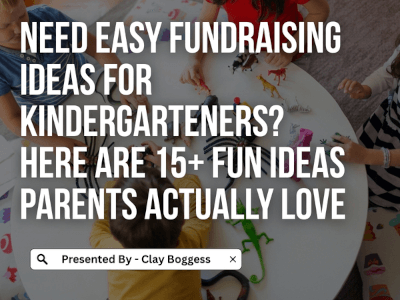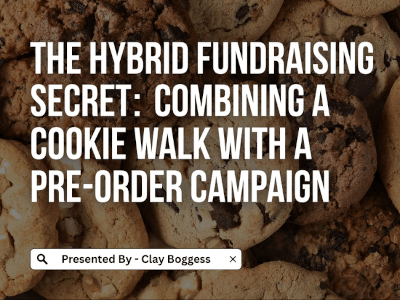
Learn how to avoid the top 5 mistakes nonprofits make.
You’ll likely be swarmed with logistical challenges when planning a fundraising event. There are plenty of distractions to keep your mind occupied.
We highlight the top 5 mistakes you should be prepared to sidestep in your fundraising event planning.
After all, the better you can anticipate these potential pitfalls, the better you’ll be able to avoid them completely.
Let’s take a look at the top mistakes that nonprofits make:
- Creating hype is an afterthought.
- The event lacks a clear objective.
- There’s not enough investment.
- The follow-up lacks strategy.
- The event software is outdated.
Recognizing a mistake is the first step in overcoming it. Likewise, awareness will be your greatest asset in fundraising, like a champion.
Let’s go over each mistake in more detail.
1. Creating hype is an afterthought.

The Mistake:
Most nonprofits probably agree that creating hype is important for an event’s success. But often, building hype is a vague concept rather than an actionable strategy.
It’s important to realize that hype incentivizes people to attend your event and donate once they’re there.
Expecting hype to occur on its own or naturally build from your advertising leaves a key element of your planning up to chance.
The Fix:
Building hype generally works best for large-scale fundraising events with a wide audience. Think walkathons or benefit concerts.
These general strategies should work across most large-scale fundraising events:
- Brand your event. Your event brand is how people will recognize your event and your organization. Brand your event by determining your theme and creating a name, logo, hashtag, and color scheme to portray that theme in your marketing materials. You’ll also want to brand your event to the specific cause you’re supporting.
- Sell merchandise in advance. Selling merchandise in advance of your event can rile up excitement. Design branded t-shirts with a universal appeal. Then, encourage supporters to share your campaign and post pics in the comfy t-shirts once they’ve purchased them. The effect of this strategy is that people will see the power of your nonprofit when hordes of supporters wear shirts in support of your organization and at the event itself.
- Capitalize on P2P fundraising. P2P fundraising is one of the best ways to build hype for an event organically. After all, people are more inclined to attend and support an event if someone they know is involved. Creating social media toolkits for your supporters can keep everyone on the same page about your mission so that they’re all communicating the same message.
These top strategies can apply to almost any nonprofit. It’s important to note, however, that large organizations may be able to seek out other means of creating hype, such as:
- Celebrity endorsements.
- Popular entertainment.
- Unique event experiences.
- Corporate sponsors.
If your organization has the means, feel free to try these strategies.
Ultimately, you’ll need to enforce a deliberate effort to create hype by making your event recognizable and reaching your event audience through your current supporters.
2. The event lacks a clear objective.

The Mistake:
Events that lack an objective can be problematic for your nonprofit.
After all, your event needs:
- A clear objective for your nonprofit.
- A clear objective for the event attendees.
Without both bases covered, your attendees won’t understand how the event supports your organization, and your organization won’t be able to measure the event’s success.
The Fix:
While planning your event, you need to constantly be aware of how your event will support specific aspects of your nonprofit. Setting an overall goal for your event can allow you to evaluate your nonprofit’s most pressing needs and respond to them.
For example, your nonprofit may want to:
- Raise $10,000 for a specific campaign.
- Communicate face-to-face with ten major donors.
- Acquire 50 new donors.
You should pair your goal with a specific, tangible cause.
For example, you may want to raise $10,000 to complete a housing project or save ten elephants. Create a goal that your attendees can quickly understand so that they know exactly how their funds will be used to help your cause.
The best goals provide context to new donors unfamiliar with your organization.
A https://www.salsalabs.com/amazing-advocacy-guide would be much different than an event celebrating bequests. Setting clear goals can help new donors understand their role in your nonprofit’s work.
For example, your mission may revolve around children’s access to education. Donors will likely understand this general concept, but you must show them how they fit into the picture.
So, your nonprofit could set this goal: raise $5,000 during the event to provide Oakland Elementary School with a new library.
To be even more specific, each attendee can contribute $50 to bring five new books to the library.
In this way, donors understand how they forward the cause, both individually and collectively, as a group.
Your goal should also be attainable to be accomplished shortly after the event.
After all, your event attendees support your philanthropy. They’ll want to see the results of their work as soon as possible.
Ultimately, clear goals keep your nonprofit focused and allow your supporters to rise to meet your expectations.
3. There’s not enough investment.

The Mistake:
When investing in your fundraising event, it’s important to be realistic about the costs it will incur. Otherwise, you could be over budget, understaffed, and stressed out.
When we talk about investment, keep in mind that fundraising events are:
- Financial investments.
- Time investments.
- Labor investments.
All these costs are vital to your nonprofit; understanding how much your fundraising event will take helps keep your nonprofit from ending up “in the red.”
The Fix:
Investing in your event can elevate it to a level that entertains your attendees and engages them as lifelong supporters and donors.
To do so, you’ll need to:
- Set a realistic budget. Your event budget should account for more than the minimum expenses. You’ll need extra funds for a backup plan (what if it rains during your outdoor event?) or medical emergencies. Additionally, you’ll want to budget for opportunities to interact with your donors and create the best possible event experience. This Big Fundraising Ideas guide has some great suggestions.
- Diversify your communication strategy. Sticking to a single communication strategy may be the easiest way to advertise, but the most effective techniques will require a tri-fold investment (money, time, labor). Video, for example, is a more complex and time-consuming means of promoting your event, but it’s also one of the most effective means of attracting new donors.
- Recruit sponsors. Recruiting sponsors takes time, but if you plan, you can offset your financial costs and receive in-kind donations to delight your donors! You should also implement a matching gifts strategy into your early planning so that donors are informed of the opportunity to double their gifts. This Double the Donation guide is a comprehensive matching gifts resource.
Investing in your event is the best way to ensure it succeeds. Events take time, effort, and money — anticipating these costs will help you raise as much as possible.
4. The follow-up lacks strategy.

The Mistake:
Your follow-up strategy is vital for retaining donors. It may seem odd to focus on a follow-up strategy during your planning, but thanking your donors and recognizing their support is a deciding factor for donors to continue their engagement.
That’s why your follow-up strategy must prioritize personal, efficient communications. How else will you reach a sea of supporters, some of whom have never interacted with your nonprofit?
The Fix:
To reach your event attendees after they’ve left your event, you can try these strategies:
- Thank donors in donation receipts. Whether selling products during your event or accepting donations, you can use donation receipts to express your gratitude. After all, you’re legally required to provide them in many cases. You might as well make the most of them to thank donors for their contributions genuinely.
- Update your event success on social media. Post updates on social media following your event. Your supporters want to know how their support has furthered your cause. Give them tangible evidence of their impact within two weeks after the event. Additionally, you can upload photo galleries from your event so attendees can tag themselves and keep virtual reminders of your organization.
- Segment donor communication. Your events may draw a large variety of supporters and donors. Segmenting your attendees based on giving level or frequency of gifts can help you craft personalized communications inviting them into your organization or expressing your gratitude for their continued support.
You should also consider your follow-up strategy with your board. In this case, metrics can give your board specific, tangible results that showcase your event’s success.
Ultimately, your follow-up strategy should account for each donor’s role within your nonprofit’s mission. Personal communications and large-scale updates that focus on your nonprofit’s cause can help you retain donors.
5. Event software is outdated.

The Mistake:
Event software is a tool that can streamline all facets of your event.
The software that your event attendees see and interact with will most likely revolve around collecting donations during your event. This is the software that you’ll need to prime for your audience; a positive giving experience can encourage your supporters to invest in your organization long-term.
Convenience and quality in your giving software will allow event attendees to transition into donors easily.
This doesn’t mean everything must be electronic or that new automatically equals better. It means that you should stay up-to-date on the top tools for your event to reach your attendees most effectively.
The Fix:
If you’re looking to innovate your event, you can plan by checking out these top technologies:
- Text-to-give. A text-to-give platform allows donors to give from their cell phones. This intuitive method is a simple, effective strategy that pairs well with fundraising thermometers or leaderboards. Attendees will be eager to raise your fundraising goal as they watch the thermometer fill up or compete against their friends.
- Mobile bidding. Mobile bidding is the new to-do in the world of silent auctions. Attendees can place bids on mobile devices and receive updates after being outbid. You’ll need plenty of exciting items to boost your attendees’ bidding (this Bidpal guide has 115!).
- On-site giving kiosk. An on-site giving kiosk allows donors to donate using their debit or credit cards easily. Many donors don’t carry cash; these kiosks keep you from missing out on giving potential!
Knowing your technology choices during your planning phase can help you create the best possible giving experience for your attendees during the event.
_____________________________________________________________________________________________________________________________________________________________
Have you made these mistakes before? Are you ready to turn your fundraising events into top-notch assets for your nonprofit?
Planning your fundraising event is no easy task. Knowing which mistakes to look out for can keep you prepared.
Guest Author Bio
Adam Weinger is one of the leading experts on corporate giving programs. He’s the President of Double the Donation, a company which helps organizations raise more money from employee matching gift and volunteer grant programs. The company partners with nonprofits ranging from arts and cultural organizations, hospitals, educational institutions, and community based organizations to help them increase fundraising from corporate giving programs.



